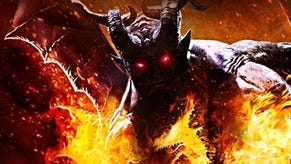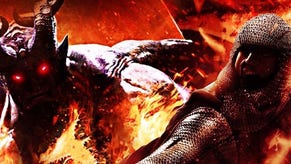Face-Off: Dragon's Dogma
Performance anxiety.
| - | Xbox 360 | PlayStation 3 |
|---|---|---|
| Disc Size | 7.9GB | 8.9GB |
| Install | 7.9GB (optional) | 4621MB (background install) |
| Surround Support | Dolby Digital | Dolby Digital, 5.1LPCM |
Capcom's MT Framework engine is known for delivering graphically impressive games that take full advantage of current-gen HD hardware. Resident Evil 5 and Lost Planet 2 amongst many others demonstrate the engine's capacity for generating highly detailed characters and complex environments, topped off with a slew of accomplished visual effects. With Dragon's Dogma, the development team has taken this a step further: the engine has been re-purposed to handle larger, open-world environments, while a fully dynamic lighting system based on deferred shading illuminates the sprawling environments with a level of accomplishment we've never seen in older versions of the engine.
But what effect does this have on the quality of the cross-platform conversion work? While previous MT Framework titles generally favoured the Xbox 360 architecture, what impact do the new rendering techniques have on image quality and performance? Could Dragon's Dogma become the first title to reach platform parity using the Capcom's impressive in-house technology?
First impressions are intriguing. The first thing we noticed is the unusually wide aspect ratio - it's closer to that of a 2:35:1 movie than the common 16:9 presentation we normally see in video games. Both versions of Dragon's Dogma are thus rendered in a sub-HD resolution (1280x608), but in order to avoid any unwanted scaling this is actually contained in a native 720p buffer with blank pixels rendered at the top and bottom of the screen.
But why make the change? The open-world design of Dragon's Dogma is particularly demanding: large-scale environments are packed full of detail, while the world is lit and shaded using a huge number of dynamic light sources, all of which put a burden on the current-gen consoles with their limited amounts of RAM and processing power. In that respect, adopting this particular kind of framebuffer set-up works as a performance-saving measure designed to reduce the overall pixel workload of both console's respective GPUs, so that these resources can be better spent enhancing the visuals elsewhere. There'll obviously be a RAM saving too in comparison to a standard 720p image buffer.
As a side effect this gives the game a slightly more cinematic look, while images appear as crisp as they would in a 'full-screen' 720p game - something you can see in the comparison video below. This is backed up by the standard Digital Foundry comparison gallery.
"First impressions are intriguing: Capcom has addressed sub-HD issues by running the game letterboxed, giving a look similar to the 2.35:1 aspect ratio seen in many movies."
Due to the switch to a deferred rendering set-up, hardware anti-aliasing has been dropped in favour of NVIDIA's post-process Fast Approximate Anti-Aliasing (FXAA), which appears to be implemented identically on both consoles. As regular MSAA (multi-sampling) doesn't play nice with deferred renderers (delivering effective edge-smoothing to the scene comes with much higher memory costs) the switch allows for a reduction in the amount of aliased edges on-screen without incurring a large performance hit.
The FXAA algorithm in play does a great job of suppressing the vast majority of jaggies equally well across both platforms, despite the high level of edge-detection blurring some of the fine details in the game's artwork. Some visible sub-pixel artifacts manifest in some scenes, but these rarely impact on overall image quality here.
Image Quality Comparisons
As is the case with many recent cross-platform titles, most of the artwork in Dragon's Dogma is basically a match across both formats, bar a few minor instances where texture detail takes a small hit on the PS3 (although you'd be hard-pressed to notice such subtle differences outside of viewing still screens). That said, texture filtering on 360 is visibly better, with higher levels of anisotropic filtering delivering extra clarity to the artwork when viewed from a distance - particularly on the ground textures which have less severe blur at extreme angles.
With regards to streaming, transitions between detail levels are very similar overall, but we do see the 360 commanding a very minor advantage. Again though, it isn't big enough to notice across the run of play. There's no mandatory install option on the PS3, but we did install the game on the 360, which could account for this. [Update: the PS3 version actually dynamically installs over 4GB of data onto the hard drive in the background, as you play.]
"Most of the artwork is exactly like-for-like, but Xbox 360 does enjoy small amounts of higher-resolution textures, better filtering and slightly improved LOD streaming compared to PS3."
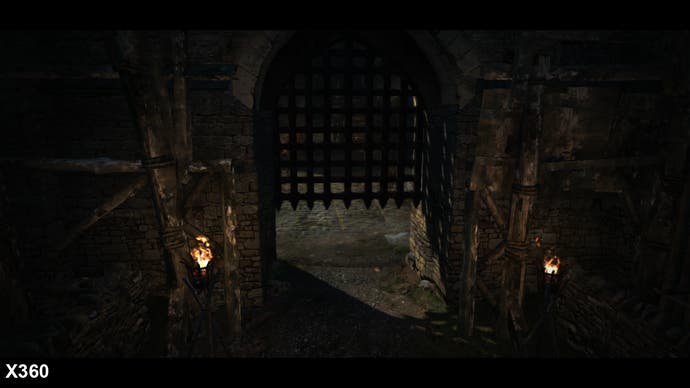
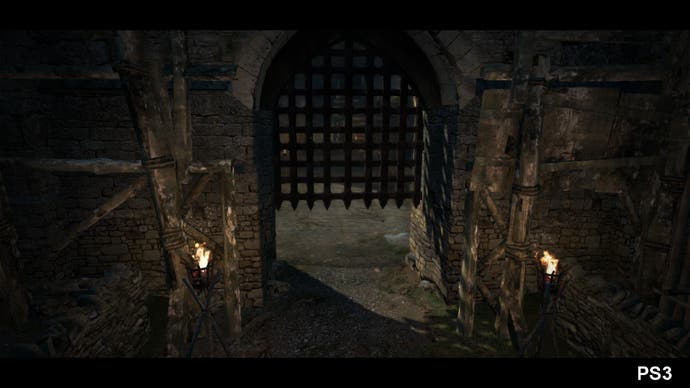
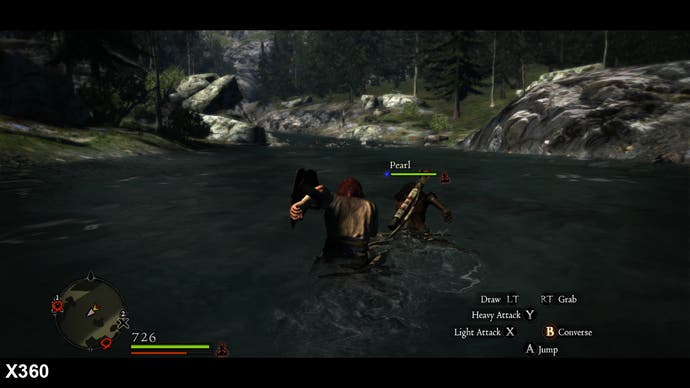
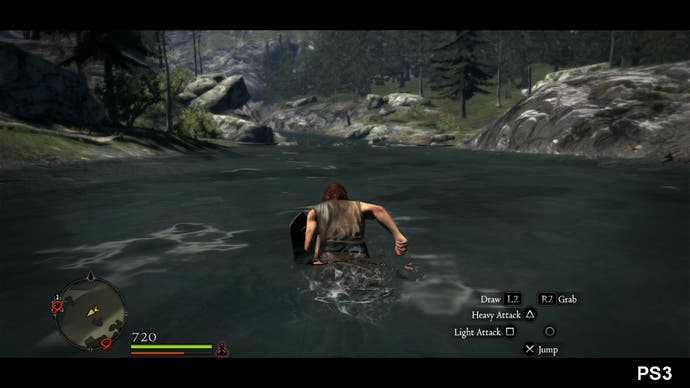
Elsewhere, most of the other effects work elements are similarly close: for example, the use of depth-of-field and motion blur appears to be a match. Likewise, the foliage and other lush greenery which litter the environments have also been replicated almost identically on both formats. Some small tufts of grass and minor aspects of the foliage have been lightly pared back on the PS3 - sometimes also being rendered in a slightly lower resolution - but you'd be hard-pressed to pick up on this outside of direct video or screenshot comparisons.
Curiously, we find that there is an unsightly dithering effect apparent on various objects as they become translucent (usually when LOD transitions occur or when these elements of the scene pass through the camera) relating to how the game handles transparent objects. Despite looking rather smooth and free from jaggies, low-resolution alpha buffers are used on both platforms, but they are blended and filtered in order to help hide the usual edge artifacts associated with this kind of effect. Bar some slightly misplaced pixels on the characters - and the aforementioned dithering - it's hard to tell that anything is amiss.
So far, so good. However, if there is one point of difference that has a noticeable effect on how the game looks on each platform, then it's the gamma set-up. Although both are adjustable, we still find that the PS3 version appears generally brighter, with less detail being crushed in dark areas, but this comes at the expense of washing out finer aspects of the artwork. In comparison, the darker look of the 360 game tends to accentuate the specular highlights found on shiny surfaces. It also manages to flesh out more high-frequency detail in some textures.
"Beyond comparisons between formats, the way in which environments are lit and shaded in Dragon's Dogma is one of the most impressive technological accomplishments found in Capcom's latest game."
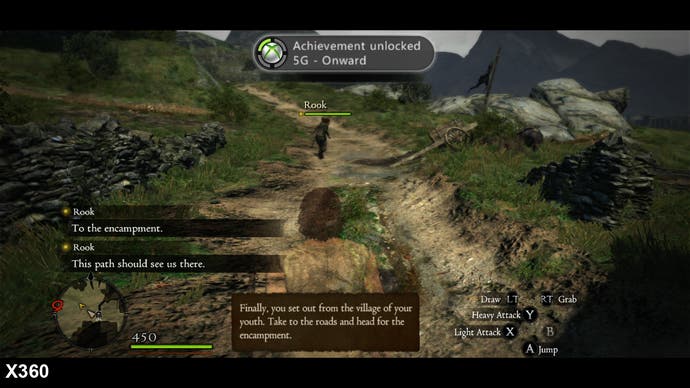

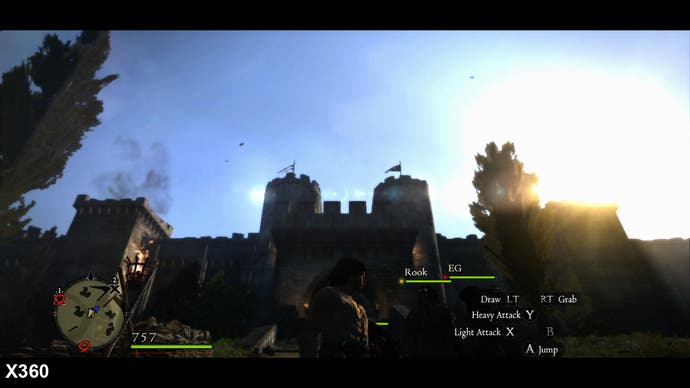

Beyond comparisons between formats, the way in which environments are lit and shaded in Dragon's Dogma is one of the most impressive technological accomplishments found in the game, especially considering the demanding open-world set-up.
The use of a real-time day/night cycle helps to create a more natural-looking world, while careful use of light and darkness breathes life into the otherwise sparsely populated environments: shadows creep cross the ground as the sun's position changes, while the intensity of the light sources slowly dim when it sets in the distance. Light shafts also beam through the surrounding scenery, accompanied by a subtle lens flare implementation, while various effects - casting spells, burning lanterns and fire - lead to a vast array of dynamic light sources appearing on-screen. The lighting model also strongly influences gameplay in night-time scenes: environments are covered in a thick veil of blackness, forcing the player to illuminate their surroundings using items found on their travels, producing some impressive real-time lighting work.
Bar some minor differences with the intensity of the lighting in some scenes, this aspect of the game is almost identical across both games: shadows are cast identically in the same places in like-for-like scenes, and any variances in some of our shots comes down to cloud coverage and the position of the sun being in different places in each version.
The abundance of shadows being cast across the environments means that they are of a very poor quality, with harsh, jagged edges visible when viewed from certain angles. However, the sheer volume of shadows in play makes up for this somewhat, helping to add additional depth and realism to the environments.
Dragon's Dogma: Performance Analysis
Moving onto performance, it's clear that the open-world set-up provides a much greater challenge for the MT Framework engine compared to Capcom's previous releases - not only are the environments considerably bigger, but the nature of the rendering load is far more unpredictable. The player is no longer confined to a reasonably linear path and this makes the game much harder to optimise. Performance profiles mirror that of previous MT Framework games: Dragon's Dogma targets a 30FPS update on both platforms, but the way each version deals with reducing screen-tear and managing frame-rate is very different.
On Xbox 360, v-sync is dropped when the frame-rate dips below the target 30FPS, thus introducing unwanted screen-tearing, but this also allows for frames to be displayed as quickly as possible, potentially delivering higher frame-rates and an improved degree of controller response. In contrast, the PS3 appears to use plain old double buffering with v-sync engaged at all times. This completely eliminates the tearing, but on the occasions where the 33ms rendering budget is exceeded, the engine basically stalls as it has to wait until the next screen refresh before displaying a new frame. When this occurs, the result is a prolonged drop down to 20FPS until the engine recovers.
An opening look at a range of battle sequences from the game - both large and small - gives some idea of how frame-rate holds up in the scenes where consistency in performance is a must. In short, the difference between 360 and PS3 versions of Dragon's Dogma comes down to a Hobson's choice between screen-tear and dropped frames.
"Performance is the biggest difference between the two games. It's a Hobson's choice between tearing on 360 or noticeably lower frame-rates on the PlayStation 3."
It's clear from the video that neither version acquits itself particularly well in combat. In the most intense encounters against the game's large foes and boss creatures, the frame-rate is heavily impacted and controller response is noticeably compromised. Neither game really comes out on top when fighting these creatures in more confined, indoor areas. However, it does appear that the Xbox 360 version recovers performance marginally more quickly than its PS3 counterpart.
Moving into the wide-open environments outside and things are considerably more one-sided. The long draw distances and abundance of alpha-based foliage visibly puts the PS3 under more stress - most of the time it lags significantly behind the 360 game, resulting in a far more uneven experience. On the flipside, while the 360 fails to maintain a solid 30FPS, it does stick more closely to the target for longer. There's a real sense that the varying frame-rate has less of a detrimental effect on the gameplay, although the large pockets of screen-tearing can be distracting.
Outside of battle, the gap isn't quite so pronounced. The 360 largely maintains a smooth 30FPS update when traversing the game's large environments, tearing when entering more detailed areas, but only really dropping frames when entering more demanding locations - the action comes across as being relatively smooth, but still quite uneven in places due to some noticeable drops occurring from time to time. Sony's console tries hard to stick to the target frame-rate, but frequently misses it to various degrees. At worst we see significant dips down to around the 20FPS mark, but we find that 24 to 28FPS updates are commonplace during a general run of play.
"Moving into the wide-open environments, things are considerably more one-sided. The long draw distances and abundance of alpha-based foliage visibly puts the PS3 under more stress."
Similar to combat, the key cause of the deficit appears to be scenes which feature a greater number of alpha transparencies and more complex geometric structures - running around a sparsely populated townscape or outdoors in foliage-packed forests equally causes a significant drop in performance.
The strict adherence to v-sync is perhaps the largest contributory factor in the PS3's frame-rate issues. Perhaps if an adaptive v-sync strategy was utilised (as we see on the Microsoft platform), we'd see a closer level of parity. Indeed, maybe the PS3 version would actually be smoother - something that is hinted at when comparing like-for-like scenes in the video below.
Analysis of these clips is quite revealing. In some scenes we find that the PS3 version manages to keep pace the 360 game despite maintaining a solidly v-synced presentation. Frame-rates are very similar, to the point where the inclusion of screen-tearing on the 360 actually makes these scenes look worse as a result. In other clips things aren't so closely matched, and we see the PS3 lose its initial advantage as smoothness drops below that of the Xbox game. Again, it seems that the appearance of particle effects and alpha are the cause here.
"In cross-platform terms, Dragon's Dogma hits the right notes in most areas, but struggles to reach complete parity, and suffers from some severe performance issues on both of the HD consoles."
Dragon's Dogma: The Digital Foundry Verdict
Capcom has managed to put together a competent enough cross-platform conversion which hits the right notes in most areas, but struggles to reach complete parity, and suffers from some severe performance issues on both systems. Image quality is effectively identical, bar the obvious gamma differences and better texture filtering on the Xbox 360, and in terms of the overall graphical make-up of the game there is very little to separate the two at all - none of the subtle differences have any impact on the look of the game or will affect your enjoyment at all.
However, where things start to diverge is with regards to performance. Across a general run of play, there's a feeling that the 360 version is the more consistent of the two where frame-rate and response are concerned. The regular bouts of screen-tearing on the 360 can be unsightly, with quick camera pans creating particularly ugly-looking scenes. However, the level of smoothness on offer makes for a more consistent experience across the board, and definitely helps gameplay during combat sequences.
Neither game acquits itself well here, but on balance we feel that the 360 game is the better performer, and from a technological perspective becomes our first choice when it comes down to the crucial purchasing decision. However, for those particularly sensitive to screen-tear, the PS3 version is the one to get - the experience is still deep and rewarding, and the game is still highly playable, but the lower frame-rate is more noticeable and is sometimes felt in the controls.
Away from graphical concerns, there is another factor to consider. Both versions of Dragon's Dogma come complete with a code granting early access to the Resident Evil 6 demo. While the 360 sampler goes live in just a little over a month, the PS3 version won't be available until the end of September, a mere month before the final game's release. On that basis the 360 game gets the final nod - early access to one of this year's biggest games is just too good a deal to pass up.
Update: Is 360 Screen-Tear Worse at 1080p?
We had an interesting email from "Cloudskipa" yesterday suggesting that Dragon's Dogma - in common with many MT Framework games on the Xbox 360 - has lower levels of screen-tear if the dashboard is set to 720p. This is a story we've heard many, many times over the years since the debut of Lost Planet and while visual comparisons we've done don't appear to support this theory, we thought we'd try for a more definitive analysis with this title.
It's worth pointing out that the Dragon's Dogma frame-rate tests above were conducted at native resolution, so if the theory is true you're still seeing performance at its best. However, we thought we would address this story head-on by recapturing a couple of cut-scenes with heavy tearing at 1080p and analysing them in relation to the original 720p sequences.
This isn't as easy as it sounds: a scaled image with screen-tear is very difficult to analyse (as the break between images isn't a single clean line anymore - the tear has been upscaled along with the rest of the image), but it is possible by downscaling the 1080p image to 480x270 using a "nearest neighbour" technique. After that we upscale up to 1280x720 for the purposes of rendering the head-to-head video. Image quality on the 1080p picture is nerfed, but upscaling blur on the tear lines is removed and thus our tools can find them.
As you can see from the video below, overall levels of tearing are basically identical and frame-rate is unaffected. Our advice? If you have a 1080p display, keep the dash set to that resolution: the 360's scaler isn't bad and it's latency free - unlike the resizing tech in your flat panel.



